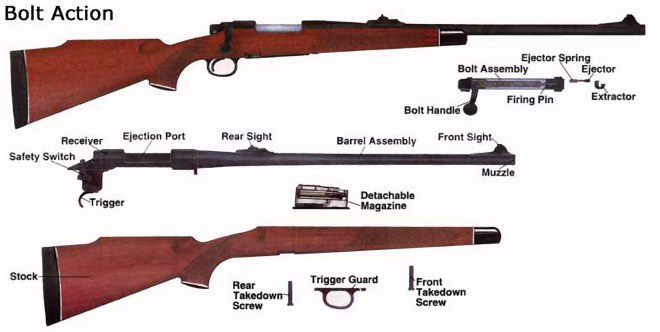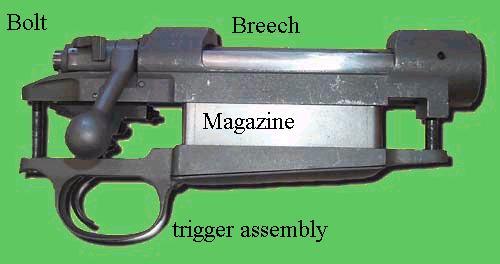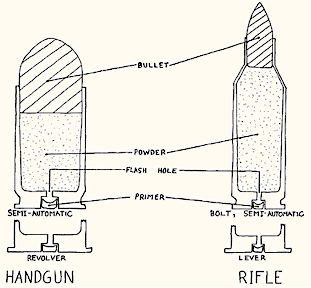Binkedpoof Speaks! | home
Why We Know What We Know About Stuff | Oskar Schindler | Schindler's List
Why We Know What We Know About Stuff
How does a gun fire?
(or more specifically)
How does a Remington Model 700 bolt action 30-06 fire?
A little about the weapon: 

This is a bolt action rifle; in both its fully assembled and field stripped diagrams. This gun was commonly used in Vietnam as a sniper rifle, it is used today for North American big game hunting and law enforcement still uses it as a snifer rifle.
So how does it work?
There are several fairly basic steps to opperating this bolt action rifle.
First of all, make sure you have the right ammo for your gun. Incorrect ammunition can result in an exploding weapon, serious injury and/or death to the operator. This particular gun takes 30-06 ammuniton (duh).
Next, you want to remove the detachable magazine. Load the magazine with the proper ammunition.
A standard magazine will hold four to five rounds of ammo (a round meaning one bullet).
Check your safety. Make sure you keep the rifle pointed in a safe direction (i.e. not at anyone or anything you don't intend to destroy) during the preparation process. Insert the magazine into the receiver, located underneath the ejection port.
Inject a round of ammunition in to the chamber by pulling back the bolt action; sliding the bolt forward will inject a round in to the chamber; ensure that your bolt is locked securely in to the receiver.
Take aim. Be careful. Breathing affects your shooting, so breath steady. Make sure you maintain the proper site picture along your site or scope.
Switch the safety from the "safe" to "fire" position. On most rifles white is safe, red is dead.
Squeeze the trigger.
Ta da. You just blew something away. I hope you meant to hit that.

Wow, cool...but how does it work?
The process that happens after you squeeze the trigger is (sort of) complex. When you open and close the bolt, you lock the firing pin in to position (the firing seer is what locks the pin back). Locking the firing pin puts tension on the spring (see picture of the bolt assembly: it's in there, wrapped around the firing pin). When you turn off the safety you allow the trigger assembly to engage the firing seer.
So when you pull the trigger the trigger assembly drops and allows the firing seer to release the firing pin which is pushed forward with lots of force by the spring. The firing pin then hits the primer really fast which makes all this friction inside the primer, igniting some phosphorous which in turn ignites the powder shoving the bullet from the casing and out the muzzle and hopefully towards whatever you wanted to hit.
Inside the muzzle is something called rifling, which are just grooves inside that make the bullet spin. The spinning creates more accuracy...kind of like spinning a football when you throw it.

This is a very important peice of your weapon!!
So what's the bullet made out of?
A bullet has several parts: the shell, or metal casing that holds everything, the powder that sits inside the casing, and the primer which has red or white phosphorous sitting in it to ignite the powder (as explained above). And then there is the most important part, the bullet itself which is the pointed thingy that flies out once the powder has ignited and hits what you're aiming at (with any luck). The casing is usually made out of brass and has several different parts as well - the names for them, however, could not be discovered.

So what's in the powder?
The powder inside the shell consists of Potassium Nitrate, which is the oxidizer for the compound, charcoal, which makes the compound burn, salt peter, basically dried pee that stabilizes the compound, and sulfar, which is an extra stabilizer and makes the whole thing smell rather badly.
So what's in the pointed thingy bullet?
The bullet generally consists of two different types of metals. The inner part is made out of lead, an extremly heavy but soft compound that allows the bullet to retain weight and expand upon impact (which causes lots of damage which of course is the goal of shooting stuff to begin with). The outer coating is made out of copper. This retains the lead inside of the bullet, allows for better forming rifling (the spin), and a better airtight lock while the bullet moves through the barrel of the gun, it also keeps the bullet from deforming in flight which helps you be more accurate. It also can expand and cause lots of damage when it hits.
That's all well and good, but how did guns get started?
Finding out the history of guns is a difficult task. Black powder, the simpilest form of gun powder, was originally discovered by the Chinese who used it to make fireworks. The British took it from there and decided to use it to blow each other up. At least, that's as much information as I can find out. Some of the biggest gun manufacturing companies are Colt (most famous for their revolver), Remington, and Winchester.
The first Remington was made in 1816 by Eliphalet Remmington II. Click here to visit the Remington site and view their company history.
Special thanks to:
Remington.com for their helpful information and pictures
the employees of Remington.com for being so helpful in answering my questions
Google for being such a wonderful search engine
the Main Street Bookstore for carrying FoxFire 5
My boyfriend Abe for all the hours of in-depth field research he forced me to undergo for this project,
and for taking the time to explain everything to me
and a pre-emptive thank you to Mr. Aunan for giving me a decent grade!